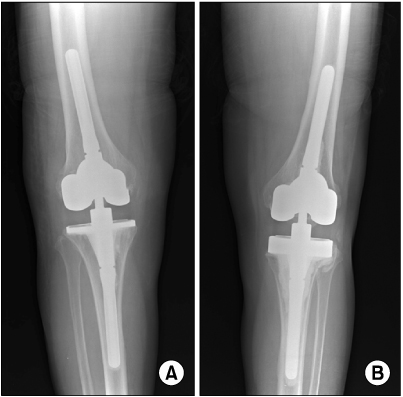J Rheum Dis.
2012 Oct;19(5):295-298. 10.4078/jrd.2012.19.5.295.
A Case of Prosthetic Knee Joint Infection Caused by Streptococcus agalactiae
- Affiliations
-
- 1Department of Internal Medicine, Kangwon National University School of Medicine, Chuncheon, Korea. kiwonmoon@kangwon.ac.kr
- KMID: 1438540
- DOI: http://doi.org/10.4078/jrd.2012.19.5.295
Abstract
- Recently the incidence of Group B streptococcus (Streptococcus agalactiae) infection has been increased in nonpregnant adults, especially including the elderly and those with underlying diseases. One year ago, a 72-year-old diabetic woman underwent both total knee replacement and then received intermittently acupuncture due to both knee pain. Five days ago, she developed painful swelling on right knee joint. The synovial fluid showed leukocytosis (WBC 8,200/mm3), she was diagnosed as prosthetic joint infection, and treated with cefazolin. Her condition was rapidly aggravated despite of antibiotics therapy, open debridement and drainage was performed. But she expired due to sepsis. Both blood and synovial fluid culture yielded S. agalactiae. We reported a case of prosthetic knee joint infection caused by S. agalactiae.
MeSH Terms
Figure
Reference
-
1. Farley MM, Harvey RC, Stull T, Smith JD, Schuchat A, Wenger JD, et al. A population-based assessment of invasive disease due to group B Streptococcus in nonpregnant adults. N Engl J Med. 1993. 328:1807–1811.2. Nolla JM, Gómez-Vaquero C, Corbella X, Ordóñez S, Garca-Gómez C, Pérez A, et al. Group B streptococcus (Streptococcus agalactiae) pyogenic arthritis in nonpregnant adults. Medicine (Baltimore). 2003. 82:119–128.3. Dubost JJ, Soubrier M, De Champs C, Ristori JM, Sauvezie B. Streptococcal septic arthritis in adults. A study of 55 cases with a literature review. Joint Bone Spine. 2004. 71:303–311.4. Zimmerli W, Trampuz A, Ochsner PE. Prosthetic-joint infections. N Engl J Med. 2004. 351:1645–1654.5. Gristina AG, Kolkin J. Current concepts review. Total joint replacement and sepsis. J Bone Joint Surg Am. 1983. 65:128–134.6. Zeller V, Lavigne M, Leclerc P, Lhotellier L, Graff W, Ziza JM, et al. Group B streptococcal prosthetic joint infections: a retrospective study of 30 cases. Presse Med. 2009. 38:1577–1584.7. Zeller V, Lavigne M, Biau D, Leclerc P, Ziza JM, Mamoudy P, et al. Outcome of group B streptococcal prosthetic hip infections compared to that of other bacterial infections. Joint Bone Spine. 2009. 76:491–496.8. Del Pozo JL, Patel R. Clinical practice. Infection associated with prosthetic joints. N Engl J Med. 2009. 361:787–794.9. Kyung HS, Mun JU. Treatment of infections after total knee arthroplasty. J Korean Orthop Assoc. 2010. 45:335–341.10. Fehring TK, Odum S, Griffin WL, Mason JB, Nadaud M. Early failures in total knee arthroplasty. Clin Orthop Relat Res. 2001. 392:315–318.11. Kim NH, Kang KS, Kwon SW, Park CS. The clinical study of pyogenic arthritis-Pathogeny and complication. J Korean Orthop Assoc. 1984. 19:1003–1011.12. Kimura K, Suzuki S, Wachino J, Kurokawa H, Yamane K, Shibata N, et al. First molecular characterization of group B streptococci with reduced penicillin susceptibility. Antimicrob Agents Chemother. 2008. 52:2890–2897.13. Borchardt SM, DeBusscher JH, Tallman PA, Manning SD, Marrs CF, Kurzynski TA, et al. Frequency of antimicrobial resistance among invasive and colonizing Group B streptococcal isolates. BMC Infect Dis. 2006. 6:57.14. Binard A, Devauchelle V, Goulesque K, Jousse S, Saraux A. Group B streptococcal arthritis. Joint Bone Spine. 2006. 73:465–468.
- Full Text Links
- Actions
-
Cited
- CITED
-
- Close
- Share
- Similar articles
-
- Streptococcus Dysgalactiae Subspecies Dysgalactiae Infection after Total Knee Arthroplasty: A Case Report
- A Case of Infective Endocarditis and Meningitis Caused by Streptococcus agalactiae
- Septic Knee Arthritis Caused by Streptococcus sanguis in a Patient with Osteoarthritis of the Knee
- Two Cases of Streptococcal Toxic Shock Syndrome Caused by Streptococcus agalactiae and Streptococcus dysagalactiae
- Primary psoas abscess caused by Streptococcus agalactiae



